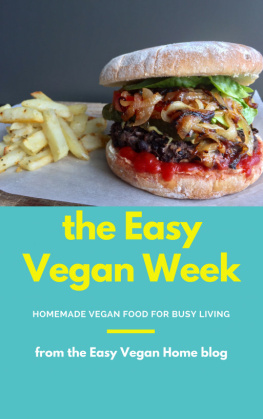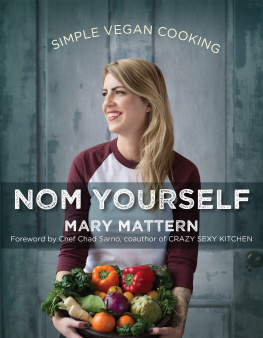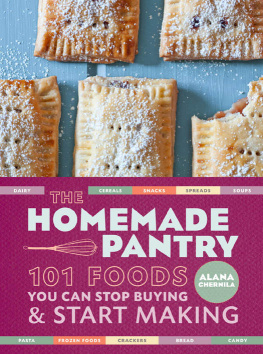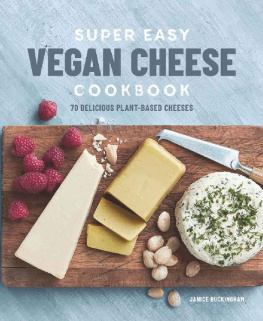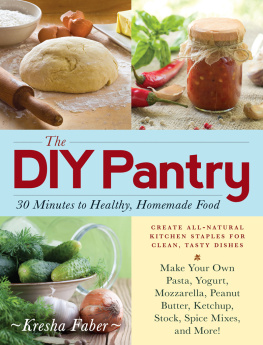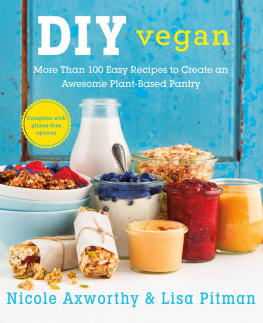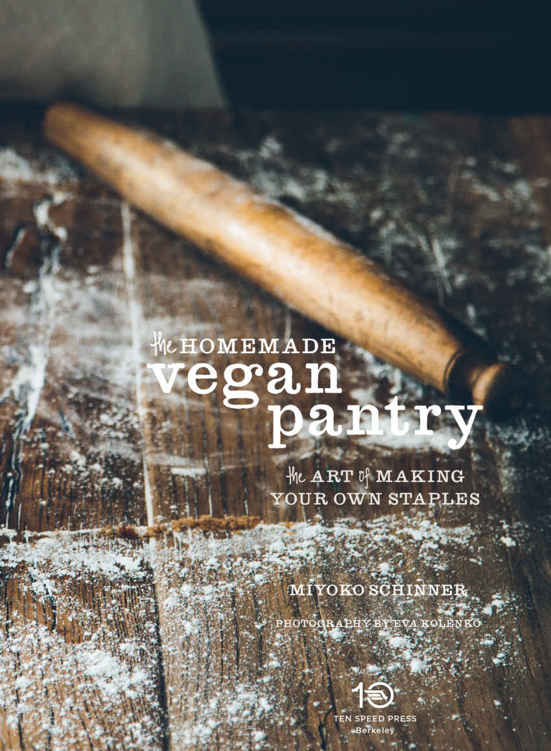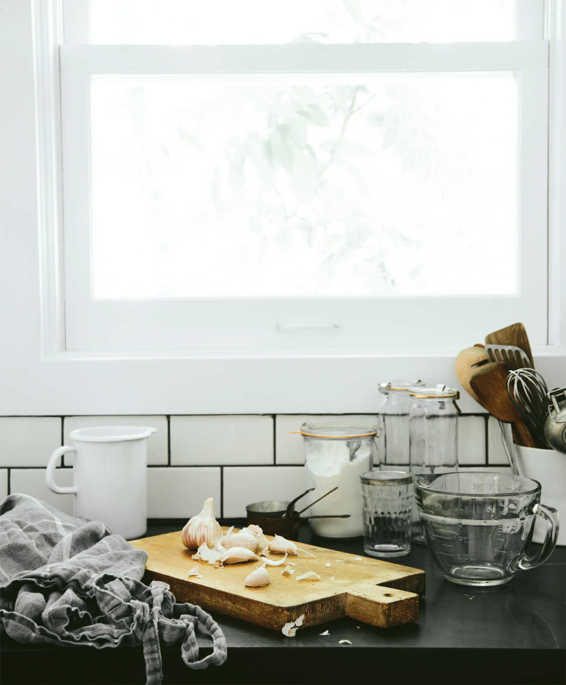Copyright 2015 by Miyoko Schinner
Photographs copyright 2015 by Eva Kolenko
All rights reserved.
Published in the United States by Ten Speed Press, an imprint of the Crown Publishing Group, a division of Random House LLC, a Penguin Random House Company, New York.
www.crownpublishing.com
www.tenspeed.com
Ten Speed Press and the Ten Speed Press colophon are registered trademarks of Random House LLC.
Library of Congress Cataloging-in-Publication Data
Schinner, Miyoko Nishimoto, 1957
The homemade vegan pantry : the art of making your own staples / Miyoko Schinner.
pages cm
1. Vegan cooking. 2. Meat substitutes. 3. Ingredient substitutions (Cooking) 4. Groceries. I. Title.
TX837.S322 2015
641.5636dc23
Hardcover ISBN: 978-1-60774-677-5
eBook ISBN: 978-1-60774-678-2
Hardcover Design by Ashley Lima
Food styling by Lillian Kang
Prop styling by Glenn Jenkins
v3.1
contents
foreword
I am a fan of cookbooks. I write them myself, but more important, I read them. I guess you could even say I breathe cookbooks. Not a wall in my home is without an overflowing bookcase full of them. Some are pristine and untouched, some are loaded with sticky notes, and some are a little too manhandled by sticky fingers. A few of those are written by Miyoko.
And so, I hope it doesnt seem odd that a cookbook author is writing a foreword for another cookbook. Youd think that wed all be gently elbowing each other out of the way for shelf space, but that is exactly why I wanted to write this in the first place.
Vegan cooking has a larger mission than, say, molecular gastronomy or French cuisine. As important as those cuisines areto our taste buds and culturally, toothey dont have the same sense of urgency. Because vegan cooking is, well, not to sound overly dramatic, trying to save the world.
Sometimes we forget about the other stuff, and the saving-the-world part takes precedent.
Now, Im not about to come down on anyone for choosing to give up animal products and reaching for the nearest meat analogue on the supermarket shelves. Im happy that those things exist! However, Id argue that the taste bud and cultural parts of vegan cooking are just as important, and in fact, we cant save the world unless we make those connections.
We need to go beyond vegan cooking. We need vegan cuisine.
Luckily, weve got the entire plant kingdom at our disposal. Vegan cuisine is uniquely positioned to be the next wave of cooking, because we can pull from every other culture and continent. Every single herb and spice, for instance, is vegan. It might seem a silly thing to say, but it comes in handy to remember when so often were told that vegan food is limiting.
But not only do herbivores need to love the food, so does everyone else, too. And, if I can get a bit brazen, Id say: it doesnt really matter if vegans love it. What matters is that everyone else does.
And thats where Miyoko comes in.
The first time I saw her was at a vegan event in Portland (of course), looking badass in a skirt and heels I could never pull off. She was certainly a commanding figure with that alone. But she also happened to be holding a big tray of vegan cheese. And I dont mean cheeze with a z. Im talking cheese! It was cultured and aged and nuanced and complex and creamy and rindy and stinky and eyes-roll-to-the-back-of-your-head delicious.
Really, one bite and I knew, its the only thing that will save the world. Because if everyone could eat like that, everyone would. And thankfully, Miyoko is sharing all of her mouthwatering recipes right here in this book.
The Homemade Vegan Pantry makes world-class vegan dishes possible for everyone at every skill level. This is all thanks to Miyoko, a chef who not only makes the best vegan cheese ever but also brings a passion to her recipes that gets both herbivores and omnivores excited about quality food that isnt as hard to make as the average person might think.
Miyoko is right there on the front lines, pushing vegan cuisine forward. Where other chefs throw down their whisks in exhaustion as they attempt to perfect vegan meringue (okay, well, Im talking about myself here), Miyoko is there, whisking away until she achieves light, fluffy perfection.
Lets follow her there, mixing bowls in hand!
From Omaha,
Isa Chandra Moskowitz
introduction
Like many of you, Im a busy parent with a busy career. Lets be honestas a chef, I love creating new dishes, inventing food products, or preparing fancy meals for dinner parties. But it can become a chore to put dinner on the table every night. It can be a chore just to think about what to put on the table every night. So, like most people, as my family grew and life became more complicated, I began to buy more packaged and premade goods, primarily things we consider to be staples, like vegan mayonnaise, marinara, veggie burgers, and so on, but sometimes even frozen entres, like pizza and veggie chicken. While all of this seemed to make my life easier, Mother Nature wasnt smiling down on me on garbage night as our familys mountain of packaging waste grew, nor did it help our pocketbook, our health, or our enjoyment of the taste and flavors of food.
What if I just stopped buying many commercial products and started making them myself? I shook with fearthe thought alone was exhausting. I knew that homemade versions of many of these staples were superior in flavor and worth the sacrifice of a bit of timeif I had the time. After all, I like slow foodbut I just want it fast.
But as I thought about it, I realized that over all my years of cooking, Id stumbled upon a number of shortcuts for classic dishes. Mind you, I cant take credit for all of the tricks, but there are a number of methods for making things faster and easier. It turns out some sacred steps arent really sacred or critical at all. You dont have to stand at the stove all day stirring risotto or polenta, for exampleyou can just stir once and then throw it in your oven and let it do the rest. As famed New York baker Jim Lahey and others have shown, theres no need to knead, a revelation that reduces bread-making to a 2-minute proposition. Making a pound of delicious, creamy vegan butter takes 90 seconds, which is probably less time than it takes to make the trek from the produce section to the butter section of your grocer. And a 60-second raw marinara that is frozen becomes a lovely cooked sauce when thawed and heated briefly.
So I started bypassing the freezer section. And one day, I made soy yogurt for the first time in years and remembered how easy it was. And then I made mayo. Then bread. Then butter to put on the bread. And eventually, the soy milk to wash it all down. And in between, so many of the other staples that fill this book, as well as the dishes that use the homemade staples. And somehow, I still had time to make those nightly dinners, and they got better because of my pantry of homemade goods.
I found that taking just a few minutes to fill your larder with staples pays off in the end, saving you hours. Take the baking mixes, for example. So you spend 10 minutes to create a multiuse mix. When you need cookies for the potluck or muffins for breakfast, you can capture that baked from scratch flavor in just moments. On a leisurely Sunday, make a large batch of so you can grab it from your freezer for a quick meal during the week. And all the classicsmayonnaise, ketchup, mustard, buttertake but a few minutes to whip up but will add panache to your cooking for weeks.



